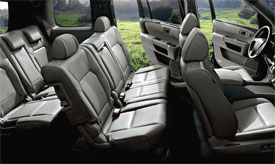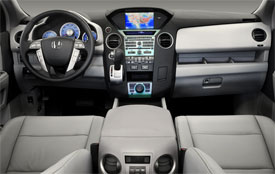2009 Honda Pilot
The Honda Pilot arrived for 2003 and almost instantly gained quite a following. In fact, it is among the best selling utilities in its class. But, with sales of family sized utilities on the fuel economy skids, the launch of an all-new 2009 Pilot could be a real weather vain. It has the same qualities as the original, with a host of upgrades, all wrapped in ever edgier styling. So can it buck high gas prices, or will the new Pilot simply flame out?
Despite being a strong contender among mid-size crossover utilities, competition for the Honda Pilot has not stood still. So, it would seem good timing for a thorough update, starting with the fact that the 2009 Pilot, for the first time, utilizes Honda’s Advanced Compatibility Engineering, or ACE body structure, which is state-of-the-art in absorbing crash energy.
Styling for the new Pilot is new too. Customers wanted a tougher, more rugged look for the Pilot, and Honda has indeed delivered.
Its truck-like look starts with a bolder front-end, spearheaded by a six-sided grille and oversized headlamps.
The profile is punctuated by well-defined fender flares and squared-off doors.
The more vertical rear now displays a standard tow hitch, and sporty exhaust tips.
The second generation Pilot also looks bigger, which it is. Sharing its chassis with the Acura MDX, wheelbase and overall length have each grown almost 3 inches: 109.2 inches for the former, and 190.9 for the latter.
But despite good intentions, the boxy stance also looks old school, and contrast greatly with sleeker, more urban friendly rivals.
 Within, you’ll find a larger 8-passenger cabin than before. Clear gauges and oversized controls are more utilitarian than upscale. Six airbags are standard. There’s a new tilt/telescopic steering wheel, as well as a new instrument panel-mounted gear shift. And oodles of small item storage.
Within, you’ll find a larger 8-passenger cabin than before. Clear gauges and oversized controls are more utilitarian than upscale. Six airbags are standard. There’s a new tilt/telescopic steering wheel, as well as a new instrument panel-mounted gear shift. And oodles of small item storage.
The firm front bucket seats are more supportive. Adds on include power, memory, and heat.
Front and rear air conditioning are standard, with a new Humidity Control System part of a Tri-Zone option.
The standard 7-speaker stereo can be upgraded to a 512-watt 10-speaker premium audio system. Options include a DVD entertainment system, and a power moon roof.
Images from the available rear-view camera show up in rear view mirror, or if you order navigation, on the larger center dash display.
The Pilot’s spacious 60/40 split second row provides an inch more legroom, and the third-row bench now has two additional inches of legroom. Behind the third row is a helpful under floor storage compartment.
And dropping all the seats gives long continuous floor an 87.6 cubic feet of cargo space. Accessible by a new hatch with separate opening glass. With power assist for the new Touring model.
Pilot power is a revised 3.5-liter single-cam V6 with variable valve timing. Output is 250 horsepower - up 6 - and 253 pound-feet of torque - up 13. Response is strong and smooth, with an aggressive note.
Surprisingly, the standard automatic transmission is only five speeds as the competition is going to six speeds. It directs power to either the front, or single speed four-wheel drive with a lock mode for low traction conditions.
Combine this with 8 inches of ground clearance, and the Pilot maintains a high degree of off-road prowess that many rivals have abandoned. And the Pilot now offers Hill Start Assist for driving on steeper grades. The four-wheel drive Pilot also boasts a 4,500 pound tow rating - a 1,000 more than last year.
 But it was around the manicured compounds of Palm Springs that we were first introduced to the new Pilot’s driving experience. With revised MacPherson strut front, and multi-link rear, and larger 17-inch tires, our impressions were that the new Pilot drives more truck-like and solid than before, and not unlike the Ridgeline that rides on a similar chassis.
But it was around the manicured compounds of Palm Springs that we were first introduced to the new Pilot’s driving experience. With revised MacPherson strut front, and multi-link rear, and larger 17-inch tires, our impressions were that the new Pilot drives more truck-like and solid than before, and not unlike the Ridgeline that rides on a similar chassis.
Vehicle Stability Control with Traction Control are standard. And the new Pilot is Honda’s first application of two-piston front brake calipers.
The Pilot’s V6 engine also adds cylinder deactivation that lets it run on only three cylinders under light loads. That helps boost fuel economy over last year to 17 city/23 highway for two-wheel drive, while four-wheel drive rates 16 city/22 highway all on regular gas.
Pilot base prices range from $28,265 to $40,665 for the all-wheel drive touring model.
All in all the 2009 Honda Pilot looks to be a very fine evolution of itself. But, with sales of larger SUVs dropping like a stone, we wonder if staying the old-form course was a right decision. Regardless, if you loved the first Pilot, you’ll love this new family crossover even more.
Specifications
- Engine: 3.5-Liter Single-cam V6
- Horsepower: 250
- Torque: 253 Lb Feet
- EPA: 17 MPG City/ 23 MPG Highway






